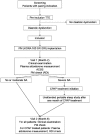Rationale and Design for a Monocentric Prospective Study: Sleep Apnea Diagnosis Using a Novel Pacemaker Algorithm and Link With Aldosterone Plasma Level in Patients Presenting With Diastolic Dysfunction (SAPAAD Study)
- PMID: 29343998
- PMCID: PMC5764134
- DOI: 10.1177/1179546817751628
Rationale and Design for a Monocentric Prospective Study: Sleep Apnea Diagnosis Using a Novel Pacemaker Algorithm and Link With Aldosterone Plasma Level in Patients Presenting With Diastolic Dysfunction (SAPAAD Study)
Abstract
Previous studies showed good agreement between pacemaker respiratory disturbance index (RDI) and polysomnography for diagnosis of severe sleep apnea (SA). The aim of this study is to investigate the diagnostic accuracy of RDI compared with apnea-hypopnea index (AHI) from a cardiorespiratory sleep study for the diagnosis of severe SA within patients requiring a pacemaker and meeting diastolic dysfunction criteria. Secondary objectives are as follows: correlation between plasma aldosterone level and SA severity, diagnostic accuracy of RDI for moderate SA, prevalence of SA among patients with diastolic dysfunction, occurrence of arrhythmias, and improvement of RDI with continuous positive airway pressure therapy. We designed a monocentric prospective nonrandomized study of prevalent cases to include 68 patients with a 6-month follow-up. Both RDI and AHI will be compared 2 months after implantation and after 1 month of continuous positive airway pressure treatment in patients with severe SA. This is the first study that examines diagnostic accuracy of pacemaker algorithm for the diagnosis of SA and correlation with plasma aldosterone levels in patients with diastolic dysfunction. Protocol version: V04. 04/04/2017 Trial registration: ClinicalTrials.gov NCT02751021.
Keywords: aldosterone; attended cardiorespiratory sleep study; diagnosis; diastolic dysfunction; sleep apnea.
Conflict of interest statement
Declaration of conflicting interests:The author(s) declared no potential conflicts of interest with respect to the research, authorship, and/or publication of this article.
Figures


References
-
- Giordanella J. Rapport sur le thème du sommeil; 2006. http://solidarites-sante.gouv.fr/IMG/pdf/rapport-5.pdf.
-
- Young T, Peppard PE, Gottlieb DJ. Epidemiology of obstructive sleep apnea: a population health perspective. Am J Respir Crit Care Med. 2002;165:1217–1239. - PubMed
-
- Somers VK, White DP, Amin R, et al. ; American Heart Association Council for High Blood Pressure Research Professional Education Committee, Council on Clinical Cardiology; American Heart Association Stroke Council; American Heart Association Council on Cardiovascular Nursing; American College. Sleep apnea and cardiovascular disease: An American Heart Association/American College of Cardiology Foundation Scientific Statement from the American Heart Association Council for High Blood Pressure Research Professional Education Committee; Council on Clinical Cardiology, Stroke Council and Council on Cardiovascular Nursing In Collaboration With the National Heart, Lung, and Blood Institute National Center on Sleep Disorders Research (National Institutes of Health). J Am Coll Cardiol. 2008;52:686–717. doi:10.1016/j.jacc.2008.05.002. - DOI - PubMed
Associated data
LinkOut - more resources
Full Text Sources
Other Literature Sources
Medical

